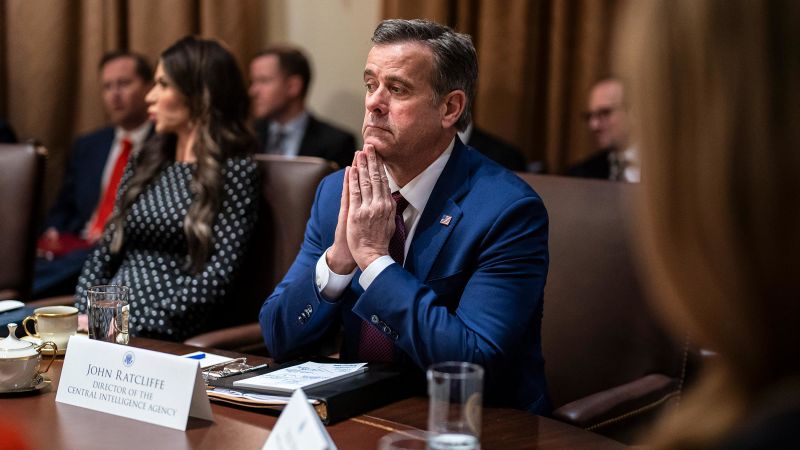In the wake of President Donald Trump’s unconventional second term, the Central Intelligence Agency (CIA) is on the cusp of a significant transformation. This shift emphasizes the elevation of covert operations, reducing the number of analysts confined to desks and seeking more operational officers willing to engage in fieldwork. The intention to reorganize the agency and implement budget cuts aligns with the Trump administration’s broader goals, casting a spotlight on CIA Director John Ratcliffe.
John Ratcliffe’s navigation of the delicate balance between aligning with the White House’s ambitions while fostering trust among CIA’s dedicated career officials is commendable. As the agency faces accusations of embodying the so-called “Deep State,” it is critical for Ratcliffe to maintain this balance to ensure operational integrity and morale within the agency. What has been observed is that Ratcliffe has adeptly shielded the CIA from the political interference that many intelligence personnel had anticipated with Trump’s continued tenure. This delicacy is vital as he mingles with Trump’s administration while obtaining loyalty and trust from the agency’s employees, positioning himself as a reliable figure even as scrutiny looms.
Despite being rooted in strategic oversight, some officials within the agency express concerns over Ratcliffe’s relative absence from operational trenches, as he appears to spend considerable time engaging with the White House. This has led to perceptions of detachment within the agency, where some staffers feel overlooked or uncertain about leadership direction. Efforts to avoid a brain drain due to uncertainty or dissatisfaction with management signify deeper issues regarding the agency’s internal morale and clarity in leadership.
Within CIA Headquarters at Langley, the sentiment towards Ratcliffe is ambivalent, with many officials describing him as the “least bad option” under Trump. This lukewarm reception is indicative of broader concerns regarding trust and operational competence among the ranks. Instead of criticism directed purely at Ratcliffe, it appears many career professionals seek stability and clarity in the organization’s future path amidst potential upheaval. Some agents worry that his frequent meetings with Trump indicate a disconnect from the field agents and operations, further unsettling agency dynamics.
Interestingly, while there are misgivings about his leadership style, Ratcliffe hasn’t enacted sweeping cuts as aggressively as other agencies have faced, despite the pressures to reshape the CIA. This has provided him an opportunity to cultivate a certain independence in managing the agency without outright capitulating to the more contentious demands of the administration. Sources familiar with the Bronx have noted that Ratcliffe may be viewed as a buffer – subtly fending off the aggressive pushes from the White House for immediate change while still working toward implementing their broader vision.
Ratcliffe’s approach stands in stark contrast to the more public-facing strategies employed by some of his peers, such as the Director of National Intelligence, Tulsi Gabbard. Ratcliffe has been strategic and reserved, positioning himself as a behind-the-scenes player in some of the administration’s leading foreign policy discussions, including matters relating to Iran and the release of American detainees in Russia. This more discreet approach allows him to navigate the politically charged waters of intelligence responsibly yet raises questions about the larger implications of his low-profile strategy amidst a rapidly evolving global landscape.
With Trump’s administration specifically emphasizing covert action and the cultivation of human intelligence, Ratcliffe appears determined to realign agency priorities away from analytical roles to those conducting on-ground operations. His plans, which involve significant staffing reductions, indicate a move toward empowering officers involved in fieldwork while diminishing the emphasis on intelligence analysis. This future focus is part of a larger response to Trump’s dissatisfaction with previous leadership and operational decisions made during Obama’s presidency that were viewed as overly analytical and entwined with bureaucratic processes.
The anticipated organizational restructuring sees proposed new mission centers prioritizing specific national security issues, such as counternarcotics efforts and counter-cartel operations, further highlighting how the agency plans to realign its core functions to better fit the strategic objectives laid out by Trump. Moreover, the recentering around covert operations showcases a significant pivot in how intelligence objectives are achieved moving forward under Ratcliffe’s leadership.
In conclusion, the CIA is poised for a significant evolution under Ratcliffe, fashioned through a mixture of calculated leadership style, political maneuvering, and concerted alignment with the White House—a scenario that has both stirred optimism and engendered concern among career professionals. Ultimately, the agency’s ability to bridge these transitions while maintaining operational effectiveness will significantly shape its future amid an ever-volatile global landscape.



